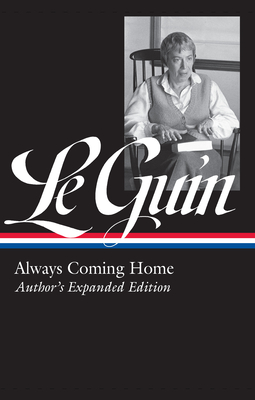Always Coming Home: Author's Expanded Edition
Ursula K. Le Guin

I have been a fan of Le Guin for a while, but I got interested in reading this book in particular from reading her essay “Utopiyin, Utopiyang” in the essay collection “No Time to Spare.” In that essay, Le Guin talks about how portrayals of utopian (and dystopian) societies in sf are heavily “yang” in the Daoist terminology–always portraying a society that has been somehow heavily designed and regimented from the top down, either for the better or for the worse. Even Le Guin’s 1974 portrayal of the anarchist society on Anarres in “The Dispossessed” (subtitled “An Ambiguous Utopia”) is yang because of the initial breakaway of Anarres from Urras, the following of a revered founding philosopher, etc. Anyway, in the essay, Le Guin tantalizingly mentions very offhandedly that her 1985 novel “Always Coming Home” is her attempt to write a “utopia of yin.”
I think she succeeds admirably with this extraordinary, unique book. I think I especially was able to appreciate it because this volume contains some essays she wrote subsequently with commentary on the book, but I think it would stand alone well too. The book is a collage-like portrait of a fictional people called the Kesh, who live in what is now Northern California (Napa Valley, the “Valley of the Na” to the Kesh) so far in the future that our own time is barely referenced in myth and story. I say “collage-like” because the book consists of several distinct segments, including commentary of an anthropologist about Kesh customs and practices, Kesh poetry, a multi-part memoir written by a Kesh woman, and a Kesh novel. I, yang-heavy though I try not to be, read it front to back, but I certainly don’t think that is necessary. There is even a recording of Kesh poetry and music that Le Guin created with a musical collaborator (“Music and Poetry of the Kesh,” with Todd Barton) that was released as a cassette tape along with the book, and that is available on Spotify, which I think is also wonderful. And there are many nice hand-illustrations in the book. It’s a lot like reading a “yin version” of those interminable appendices in the back of the Lord of the Rings books.
It’s a “utopiyin” in many different ways. Although it purportedly exists in the far future, Kesh society is very heavily influenced by the Native American societies of Northern California. This broadly manifests in living in cooperation with the land and the seasons rather than dominating over them (contrasted with the contemporaneous society of the Condor). Kesh society is also notably non-patriarchal (and non-matriarchal); while many traditions are described and explained, none has the feeling of a “comprehensive system” and everything is a bit tentative or incomplete, by construction–kind of reminds me of the classification of animals recounted by Borges: “those that belong to the emperor, stray dogs, those that just broke the flower vase, those that at a distance resemble flies,” etc. This all has a very personal feel because Le Guin’s parents, Alfred and Theodora Kroeber, were anthropologists who studied Native Northern Californian cultures (and who produced the book “Ishi in Two Worlds”) and Le Guin was very steeped in these ideas and lore as a child–it’s not the work of a dabbler. There is a little bit of “high tech” mixed in, in the form of the existence of a basically fully intelligent AI society that has colonized beyond the earth and that interacts, occasionally and with a very soft touch, with the Kesh. I also thought Le Guin pushed this just the right amount to keep it from feeling purely like a story about the past but to avoid having technology be the focal point of the book.
In one of the accompanying essays, Le Guin writes about how, in her view, writing about the distant past and the distant future are really not that different. The traces we have left of ancient cultures are hardly any more than what we can extrapolate about future cultures from today, and we have no choice but to largely fill in the gaps with our own imaginings. This is a very nice Daoist-feeling point. As far as being a “utopiyin” goes, Le Guin writes that part of the yanginess of most utopias is the bare fact that they are designed to be something new or never-before-seen, and that she realized that a utopia of yin might, by definition, be based largely on things that already existed but had been ignored, forgotten, or disappeared.
This book is an undertaking for sure, clocking in at almost 800 pages with the accompanying texts. But you can be less yang than me and read it out of order, over a longer time, or even not read every last bit! I found it very rewarding and would love to spend more time with the Kesh.